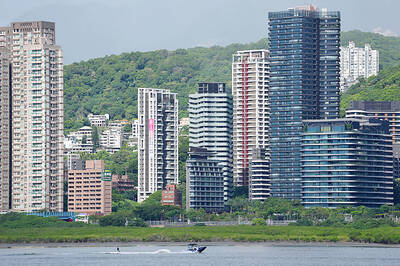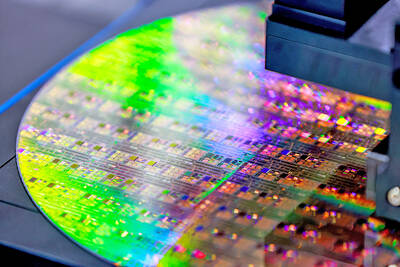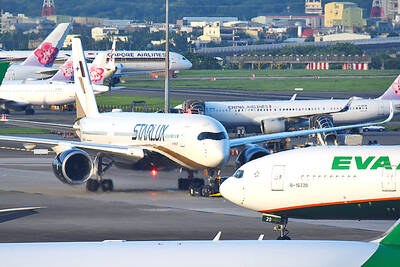Shrimp are one of the most popular seafoods globally, but farmed production of the crustaceans can have a devastating effect on local habitats — and in some cases the climate. A Singapore-based start-up says it has a new planet-friendly solution for growing the food without the sea.
When along coastlines, shrimp farms can generate a steady stream of chemicals, feces and antibiotics that are pumped back into the ocean. While that is worrying enough, the industry has also been linked to global warming.
Thirty percent of the destruction of mangroves — a powerful carbon sink — and coastal land-use change in Southeast Asia have been attributed to shrimp farming, nonprofit think tank Planet Tracker said.

Photo: AP
Trawling for wild shrimp can affect other marine life and destabilize fragile ecosystems. By the time seafood reaches dinner plates in the US, Europe or Japan, it has often traveled thousands of kilometers from farms in Brazil, China or Thailand — racking up a hefty carbon footprint.
To that end, shrimp farming’s best future might look like a mashup of a data center and a parking garage — if Vertical Oceans has anything to do with it.
The start-up says its algorithms enable shrimp production in autonomous tanks, which it plans to stack near onshore demand centers such as Las Vegas or Tokyo, eliminating ocean discharge.
The approach produces locally grown food harvested and delivered to your doorstep the same day.
“We’re demonstrating what the future of efficient protein production could look like,” cofounder and chief executive officer John Diener said.
Vertical Oceans is the latest company aiming to develop more sustainable onshore aquaculture models for core food sources.
Land-based production of salmon, for instance, can offer ecological benefits when the fish are raised in saltwater pens because it removes the animals from natural marine habitats, eliminating the risk they can pass on viruses and parasites to wild species.
Investor appetite for food-related technology companies is surging with venture capitalists last year plowing more than US$39 billion into the sector, double the amount they financed the year before, research group Pitchbook Data Inc said.
Although more than half of that funding went to digital grocers and online marketplaces, aquaculture is poised to become a larger part of the supply chain.
Venture capital firms Khosla Ventures and SOSV invested a combined US$4 million during Vertical Oceans’ seed round in the middle of last year.
Risks for systems like the one Vertical Oceans is building are that if either the mechanical or biological system breaks down, things can go awry, said Cyr Couturier, a marine biologist and aquaculture scientist at the Fisheries and Marine Institute of Memorial University of Newfoundland in Canada.
Companies can encounter challenges when they attempt to scale up production, although Vertical Oceans’ modular design should allow it to expand in small increments, as long as it can service capital requirements, he said.
Couturier said he has seen multiple systems for salmon and shrimp production run into problems over the past decade because engineers did not understand how the organisms would interact with the facilities they built.
“Biological systems are often unpredictable over the longer term,” Couturier said in an e-mail.
Vertical Oceans’ tanks are about the size of a school bus. They aerate and recirculate the water, feed the shrimp and use macro-algae like umibudo to gobble up nitrogen, phosphorus and feces, eliminating the need to discharge waste water, Diener said.
The company does not use any chemicals or antibiotics in production and the multispecies environment results in a much healthier aquatic ecosystem.
“The reason we’re able to avoid bacterial pathogenic problems is largely because we’ve got this healthy and more balanced ecosystem,” Diener said.
There is also hope that tank-grown seafood can deliver on the most important point for most consumers: taste.
Scientists have found that ocean acidification — caused by excessive amounts of dissolved carbon dioxide — is making shellfish less appealing.
Vertical Oceans has produced about 1 tonne of shrimp so far through a proof-of-concept project on a small recreational island off the coast of Singapore and is looking to open its first commercial site in the US next year.
The company has been selling directly to consumers in Southeast Asia and supplying local eateries, including Singapore restaurant Open Farm Community.

Taiwan’s rapidly aging population is fueling a sharp increase in homes occupied solely by elderly people, a trend that is reshaping the nation’s housing market and social fabric, real-estate brokers said yesterday. About 850,000 residences were occupied by elderly people in the first quarter, including 655,000 that housed only one resident, the Ministry of the Interior said. The figures have nearly doubled from a decade earlier, Great Home Realty Co (大家房屋) said, as people aged 65 and older now make up 20.8 percent of the population. “The so-called silver tsunami represents more than just a demographic shift — it could fundamentally redefine the

The US government on Wednesday sanctioned more than two dozen companies in China, Turkey and the United Arab Emirates, including offshoots of a US chip firm, accusing the businesses of providing illicit support to Iran’s military or proxies. The US Department of Commerce included two subsidiaries of US-based chip distributor Arrow Electronics Inc (艾睿電子) on its so-called entity list published on the federal register for facilitating purchases by Iran’s proxies of US tech. Arrow spokesman John Hourigan said that the subsidiaries have been operating in full compliance with US export control regulations and his company is discussing with the US Bureau of

Businesses across the global semiconductor supply chain are bracing themselves for disruptions from an escalating trade war, after China imposed curbs on rare earth mineral exports and the US responded with additional tariffs and restrictions on software sales to the Asian nation. China’s restrictions, the most targeted move yet to limit supplies of rare earth materials, represent the first major attempt by Beijing to exercise long-arm jurisdiction over foreign companies to target the semiconductor industry, threatening to stall the chips powering the artificial intelligence (AI) boom. They prompted US President Donald Trump on Friday to announce that he would impose an additional

China Airlines Ltd (CAL, 中華航空) said it expects peak season effects in the fourth quarter to continue to boost demand for passenger flights and cargo services, after reporting its second-highest-ever September sales on Monday. The carrier said it posted NT$15.88 billion (US$517 million) in consolidated sales last month, trailing only September last year’s NT$16.01 billion. Last month, CAL generated NT$8.77 billion from its passenger flights and NT$5.37 billion from cargo services, it said. In the first nine months of this year, the carrier posted NT$154.93 billion in cumulative sales, up 2.62 percent from a year earlier, marking the second-highest level for the January-September